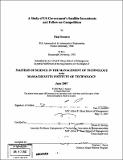| dc.contributor.advisor | Fiona E. Murray. | en_US |
| dc.contributor.author | Scearce, Paul (Paul Taylor) | en_US |
| dc.contributor.other | Management of Technology Program. | en_US |
| dc.date.accessioned | 2007-11-16T14:14:42Z | |
| dc.date.available | 2007-11-16T14:14:42Z | |
| dc.date.copyright | 2007 | en_US |
| dc.date.issued | 2007 | en_US |
| dc.identifier.uri | http://hdl.handle.net/1721.1/39503 | |
| dc.description | Thesis (S.M.M.O.T.)--Massachusetts Institute of Technology, Sloan School of Management, Management of Technology Program, 2007. | en_US |
| dc.description | Includes bibliographical references (leaves 68-76). | en_US |
| dc.description.abstract | In many high technology industries, incumbents routinely find themselves loosing to new entrants as well as established competitors in the battle for leadership across successive generations of new technology. However, the demise of the incumbent is most typically associated with the entry of start-up firms particularly in settings with minimal complementary assets, few intellectual property rights and limited technical expertise. This thesis will explore a different competitive setting - the U.S. Government's unclassified satellite competitions - an arena characterized by deep technical skills, strong and lasting complementary assets and robust IP. Given these strengths, we would expect to find that incumbents would successfully win most competitions. In fact, according to newly gathered data, satellite producers for the U.S. Government have historically experienced an almost 90% loss rate in follow-on satellites competitions. This pattern is prevalent in satellite competitions undertaken by the National Aeronautical and Space Administration (NASA), the National Oceanographic and Atmospheric Administration (NOAA), the United States Air Force (USAF) and the United Stated Navy (USN). | en_US |
| dc.description.abstract | (cont.) The winners of these competitions are not to new entrants into the satellite business, but rather they are other established aerospace companies - suggesting that it is more than "organizational newness" that leads to success and more than age that leads to obsolescence. Anecdotal drivers of this trend abound, however, there is no systematic examination of the satellite industry and few settings in which the loss of incumbents to other large and established firms have been extensively analyzed. This thesis is an attempt to unravel the puzzling and repeated loss of incumbents to organizations that are in many ways very similar in terms of size, bureaucracy, technology etc. and yet which seem to be able to out-compete the winners of prior competitions over 90% of the time. This thesis argues that three factors drive this trend: 1. Non-incumbents leverage new architecture innovations to provide superior performance 2. Non-incumbent management encourages pursuit of architectural innovation 3. Non-incumbent optimistic bias enables aggressive bidding to win. | en_US |
| dc.description.statementofresponsibility | by Paul Scearce. | en_US |
| dc.format.extent | 94 leaves | en_US |
| dc.language.iso | eng | en_US |
| dc.publisher | Massachusetts Institute of Technology | en_US |
| dc.rights | M.I.T. theses are protected by copyright. They may be viewed from this source for any purpose, but reproduction or distribution in any format is prohibited without written permission. See provided URL for inquiries about permission. | en_US |
| dc.rights.uri | http://dspace.mit.edu/handle/1721.1/7582 | |
| dc.subject | Management of Technology Program. | en_US |
| dc.title | A study of US government's satellite incumbents and follow-on competitions | en_US |
| dc.title.alternative | Study of United States government's satellite incumbents and follow-on competitions | en_US |
| dc.type | Thesis | en_US |
| dc.description.degree | S.M.M.O.T. | en_US |
| dc.contributor.department | Management of Technology Program. | en_US |
| dc.contributor.department | Sloan School of Management | |
| dc.identifier.oclc | 173843193 | en_US |
